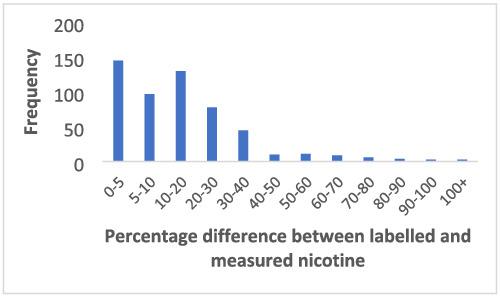当前位置:
X-MOL 学术
›
Drug Test. Anal.
›
论文详情
Our official English website, www.x-mol.net, welcomes your feedback! (Note: you will need to create a separate account there.)
A review of nicotine‐containing electronic cigarettes—Trends in use, effects, contents, labelling accuracy and detection methods
Drug Testing and Analysis ( IF 2.9 ) Pub Date : 2021-01-15 , DOI: 10.1002/dta.2998 Amelia Taylor 1 , Keeley Dunn 1 , Sophie Turfus 1
Drug Testing and Analysis ( IF 2.9 ) Pub Date : 2021-01-15 , DOI: 10.1002/dta.2998 Amelia Taylor 1 , Keeley Dunn 1 , Sophie Turfus 1
Affiliation

|
Electronic cigarettes (ECs) are thought to be less harmful than traditional combustible cigarettes and were originally intended to help smokers quit. Over the past two decades, they have especially gained popularity with the younger generation. To date, there are over 7000 unique e‐liquid flavours available and over 400 different e‐cigarette brands. The accuracy of nicotine strength labelling in e‐liquids was assessed in this work. Twenty‐three studies from around the world were chosen to assess the level and frequency of nicotine mislabelling in 545 e‐liquid products. Nicotine strengths were most commonly mislabelled by between 5% and 20%, with the majority testing lower than what the label indicated. Fifteen European e‐liquids that were assessed were labelled as 20 mg/ml or less, yet when tested, they contained more than 20 mg/ml of nicotine. One e‐liquid that was supposed to contain no nicotine in fact contained 23.91 mg/ml of nicotine. Furthermore, the difference between the medians of the available labelled and experimental nicotine concentrations was significant (p < 0.001, Wilcoxon signed rank test). Preliminary studies show that high nicotine levels delivered via aerosol increase the risk for nicotine poisoning and cause airway inflammation. Other EC ingredients, such as flavourings, contribute to EVALI and ‘popcorn lung’. There is evidence that certain flavourings, such as menthol, reinforce the effects of nicotine and modify drug absorption and metabolism. There is a global need for better quality control in EC products in order to make these safe for consumers.
中文翻译:

含尼古丁电子烟综述——使用趋势、效果、含量、标签准确性及检测方法
电子烟 (EC) 被认为比传统可燃香烟危害更小,最初旨在帮助吸烟者戒烟。在过去的二十年里,他们特别受到年轻一代的欢迎。迄今为止,有超过 7000 种独特的电子烟油口味和 400 多个不同的电子烟品牌。在这项工作中评估了电子液体中尼古丁强度标签的准确性。选择了来自世界各地的 23 项研究来评估 545 种电子烟油产品中尼古丁贴错标签的水平和频率。尼古丁强度最常被错误标记为 5% 到 20%,大多数测试低于标签指示的值。被评估的 15 种欧洲电子烟液被标记为 20 毫克/毫升或更少,但在测试时,它们含有超过 20 毫克/毫升的尼古丁。一种本应不含尼古丁的电子烟油实际上含有 23.91 毫克/毫升的尼古丁。此外,可用的标记和实验尼古丁浓度的中位数之间的差异是显着的(p < 0.001,Wilcoxon 符号秩检验)。初步研究表明,通过气雾剂传递的高尼古丁水平会增加尼古丁中毒的风险并导致气道炎症。其他 EC 成分,例如调味剂,有助于形成 EVALI 和“爆米花肺”。有证据表明,某些调味剂,例如薄荷醇,可以增强尼古丁的作用并改变药物吸收和代谢。全球需要对 EC 产品进行更好的质量控制,以确保这些产品对消费者安全。
更新日期:2021-02-10
中文翻译:

含尼古丁电子烟综述——使用趋势、效果、含量、标签准确性及检测方法
电子烟 (EC) 被认为比传统可燃香烟危害更小,最初旨在帮助吸烟者戒烟。在过去的二十年里,他们特别受到年轻一代的欢迎。迄今为止,有超过 7000 种独特的电子烟油口味和 400 多个不同的电子烟品牌。在这项工作中评估了电子液体中尼古丁强度标签的准确性。选择了来自世界各地的 23 项研究来评估 545 种电子烟油产品中尼古丁贴错标签的水平和频率。尼古丁强度最常被错误标记为 5% 到 20%,大多数测试低于标签指示的值。被评估的 15 种欧洲电子烟液被标记为 20 毫克/毫升或更少,但在测试时,它们含有超过 20 毫克/毫升的尼古丁。一种本应不含尼古丁的电子烟油实际上含有 23.91 毫克/毫升的尼古丁。此外,可用的标记和实验尼古丁浓度的中位数之间的差异是显着的(p < 0.001,Wilcoxon 符号秩检验)。初步研究表明,通过气雾剂传递的高尼古丁水平会增加尼古丁中毒的风险并导致气道炎症。其他 EC 成分,例如调味剂,有助于形成 EVALI 和“爆米花肺”。有证据表明,某些调味剂,例如薄荷醇,可以增强尼古丁的作用并改变药物吸收和代谢。全球需要对 EC 产品进行更好的质量控制,以确保这些产品对消费者安全。


























 京公网安备 11010802027423号
京公网安备 11010802027423号